


Ardelt 8,8 cm Pak43-3 Waffentrager Kubinka
English Translation
Le Ardelt 8,8 cm Pak 43 / 3 Waffenträger
Les Allemands comme les autres belligérants ont mis au point durant la Seconde Guerre mondiale une nouvelle arme l’artillerie motorisé en allemand Waffenträger
Mais tout d abord voyons qui est cette firme Ardelt
Ardelt
.jpg) |
Ardelt a été une marque de fabrication de matériel ferroviaire et des grues
Elle a été fondée en 1902 par Robert D. Ardelt initialement pour la réparation de machines et d'équipement d'usine, mais aussi comme un bureau d'ingénierie travaillant sur des projets de tout particulièrement en provenance des fonderies.
En août 1904, il connait une première extension par l'achat d'une ancienne usine La société se fait connaître sous le nom de Robert Ardelt et Sons Elle a des succursales en Belgique, en France, la Russie, la Pologne, l'Espagne et aussi en Inde et en Australie En 1917, elle a été le fournisseur de grues dans le Reich allemand.
Dans les années 1930, elle a été le leader sur le marché de locomotive
Suite à la 2° Guerre Mondiale et après la perte de l'usine de Leipzig qui devient l’usine Kirov une nouvelle usine est créée à Wilhelmshaven et Osnabrück. Maintenant Ardelt est devenu Ardelt Krupp Gmbh.
Histoire
Il s'agit engin blindé anti char, il doit être simple mais puissant avec un canon anti-anti char
Les premières ébauches commencent en 1943 avec la conception initiale de Waffenträger sur la base du châssis complexe du PZ III/ IV
Mais le Wa Prut 4 (service du matériel n° 4) décide que ceux-ci sont trop lourds et coûteux pour du matériel d’artillerie
En Février 1944, un nouveau cahier des charges est déposé avec des Waffenträger qui doivent remplacer les pièces d'artillerie tractées
Les caractéristiques sont les suivantes
.jpg) |
.jpg) |
| Internet | Internet |
.jpg) |
.jpg) |
Le Ardelt 8,8 cm Pak 43 / 3 sera un Waffenträger avec une petite silhouette. Cela sera donc une simple plate-forme équipée d'un puissant canon anti-char une faible garde au sol et un blindage épais de 20 mm sur l’avant et de 10 mm sur le côté. La garde au sol ne doit pas dépasser le 500 mm, l'autonomie doit être comprise entre 100 à 150 km et il emporte un équipage de 4 hommes
Là encore, l'arme devra être démontable, transporté sur le glacis arrière sans équipement particulier Seul un bouclier protège l'équipage. Le tube doit pouvoir tourner sur 360 ° en azimut et de -8 ° à + 45° en site La dotation en munitions doit être de 50 obus. Une remorque peut être tracté avec 20 autres coups complets
Krupp sera le maitre d œuvre du projet, mais d'autres sociétés sont impliquées dans la construction de sous-ensembles telles que Rheinmetall pour le canon et le châssis, et Ardelt Steyr pour le châssis
Le projet a été dirigé par Herr Woelfert. initialement il avait été prévu le poste de conduite à l arrière mais on revient à une position plus classique avec le poste de conduite à l avant et tout l arrière est laisse pour le canon
Steyr produit le prototype avec un train de roulement basé sur l'ARS, Rheinmetall produit un prototype sur la base des 38 t et Ardelt un prototype basé sur le HETZER
Le prototype Ardelt est choisi par Hitler en août 1944, sous la désignation GW 638/26, Gerät 587
Pourquoi ce choix?
Ayant pris conscience de l'extrême urgence de l'instant, Ardelt propose un engin simple petit économique et rapide a construire
Le moteur et transmission sont placés a la droite du conducteur et le compartiment conducteur est placé bas dans le châssis afin que le canon ait un volée en site négatif plus importante
Des prototypes ont été construits à la fin de 1944. La production sera basée sur le 38D (Deutchland), qui diffère du 38 (t) par un plus grand châssis, une autre transmission, un nouveau train de roulement et un moteur TATRA-103 220p . ,Les caisses de munitions sont stockées à l'arrière dans des emplacements prévues dans la plate forme arrière.
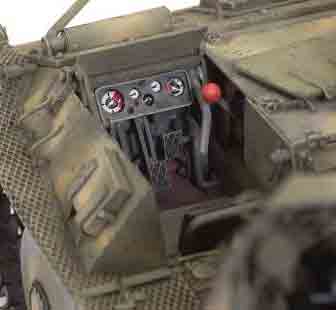 |
| Poste de Conduite |
À la fin de 1944, un deuxième prototype est construit en utilisant le châssis de PzKpfW 38 (t). Le canon de 10,5 cm est utilisé pour armer le modèle
Un prototype 38D avec montage du 43 PAK 8.8 est testé à Hillersleben le 27 avril 1945
Le démarrage de la production est prévu pour le mois d'avril 1945 avec une production mensuel de 350 exemplaires pour Septembre 1945.
Peu de Waffenträger ont été équipées avec le 8,8 cm anti-char canon Pak 43 / 3 L71
Waffenträger Au cours de la Bataille de Berlin un véhicule sa été vue en action en avril 1945, près de la porte de Brandebourg à Berlin avec 3e Panzer Jaeger Abt. De la division d'infanterie "Ulrich von Hutten" ..
Au moins deux véhicules ont été capturés par l'Armée rouge et l'un d'eux est conservé au Musée Kubinka.
.jpg) |
.jpg) |
.jpg) |
.jpg) |
Caractéristiques
Poids: 11200 kg
Equipage 4
Longueur 7 .270 m / avec canon
Largeur 2.440
Hauteur 2,4 m
Moteur
Vitesse 36 km / h
Gamme de 150 km
Armor 20 mm maxi
Arme
8,8 cm Pak 43 / 3 L71 avec 50coups +r 20 dans une remorque
Radio FuG 16
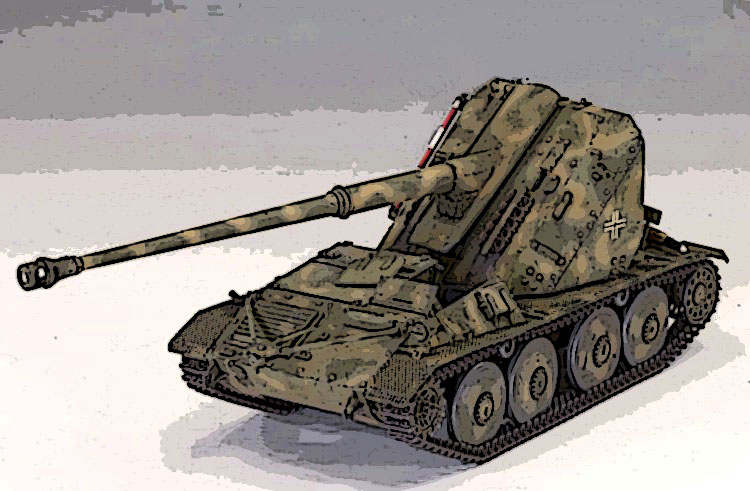 |
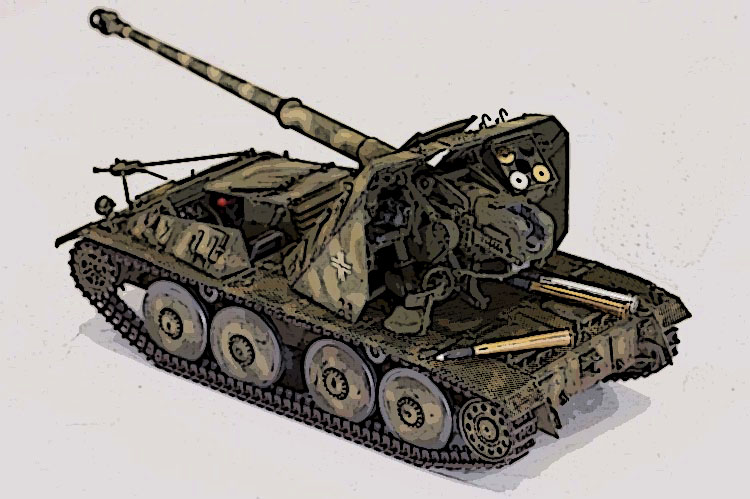 |
.jpg) |
.jpg) |
.jpg) |
| Merci à Vincent |
The Ardelt 8.8 cm Pak 43 / 3 Waffenträger
.jpg) |
During WWII Germans like the other belligerents have bring in focus a new class of motorized artillery in German Waffenträger
But first who his Ardlet
Ardelt
.jpg) |
Ardelt was a factory know for rail wail equipment and cranes
It was founded in 1902 by Robert Ardelt d. initially for the repair of machinery and factory equipment, but then as an engineering office with drafts of entire plant, especially from foundries.
In August 1904, the first expansion through the purchase of an old factory The Company was known under the name Robert Ardelt & Sons Ltd. She has branches in Belgium, France, Russia, Poland, Spain and also in India and Australia. In 1917 she was the provider for cranes in the German Reich.
In the 1930s, she was the leader on the locomotive market
After WW 2 after the lost of the plant in Leipzig who become Kirov factories a new plant in Wilhelmshaven and Osnabruck was founded. Now Ardelt was Krupp Ardelt GmbH.
History
It was a Anti tank jäger it would be simple but with a powerful anti tank gun
Design begin in 1943 with Initial design for Waffenträger based on the large and complicated PZ III IV chassis
But the Wa Prüt 4( ordnance Proving Branc 4) decided that these are too heavy and to costly for artillery purpose
In February 1944 a new specification was issues for a Waffenträger to replace towed artillery weapons
This specifications are
.jpg) |
.jpg) |
| Internet | Internet |
.jpg) |
The Ardelt 8.8 cm Pak 43 / 3 Waffenträger would be have a low silhouette . He was a simple tracked platform equipped with a powerful anti-tank gun with a small footprint and lower body with an armour of 20 mm and 10mm shielding side. The spacecraft must be, with a floor height not exceeding 500 mm The autonomy would be of s 100 to 150 km and ha has a crew of 5 men
Again the weapon would be dismountable but from a low rear platform without special equipment Only a shield protects the crew . The tube must have a travel firing of 360 ° and a setting site ranging from -8 ° to + 45 in The endowment ammunition must be 50 shells. A trailer can be towed with 20 additional shot
Krupp was the responsible for the project but other companies are involved in the construction of sub-assemblies which Rheinmetall for the gun and the chassis , Ardelt and Steyr for the chassis
The project was managed by Herr Woelfert . initially it was proposed to have a rear drive but the constraints push to a more conventional front drive who was adopted and allowed on a lower gun platform
Steyr produced the prototype with a running gear based on the RSO, Rheinmetall produced a prototype based on the 38 t and Ardelt a prototype based on the Hetzer
The Ardelt prototype was accepted for production by Hitler in August 1944, under the designation GW 638/26, Gerät 587
.jpg) |
.jpg) |
.jpg) |
Why this choice ?
Because having become aware of the extreme urgency of the moment, Ardelt propose a gear light, small and economic design allowed accelerated production
Engine and transmission were place to the right of the driver and the driver compartment could be folded to give increased depression to the gun
Prototypes were built in late 1944 . Production would be based on the 38D (Deutschland), which differs from 38 (t) by a larger chassis, a different transmission, a new rolling train and an engine TATRA-103 220p Crates of ammunition storage are located at the back in boxes under the platform of fire.
.jpg) |
| Driver |
At the end of 1944, a second prototype is built using the chassis of PzKpfW 38 (t). The barrel of 10.5 cm is used to arm the model
A prototype 38d mounting a 8.8 PaK 43 was tested a Hillersleben on April 27th 1945
The start of production is planned for April 1945 with a monthly production of 350 copies is planned for September 1945.
Few Waffenträger were equipped with the 8.8 cm anti-tank gun Pak 43 / 3 L71
Waffenträger at war
During the Berlin Battle One vehicle was se action in April of 1945, near Berlin at Brandeburg
with 3rd Panzer Jaeger Abt. attached to Infantry Division "Ulrich von Hutten"..
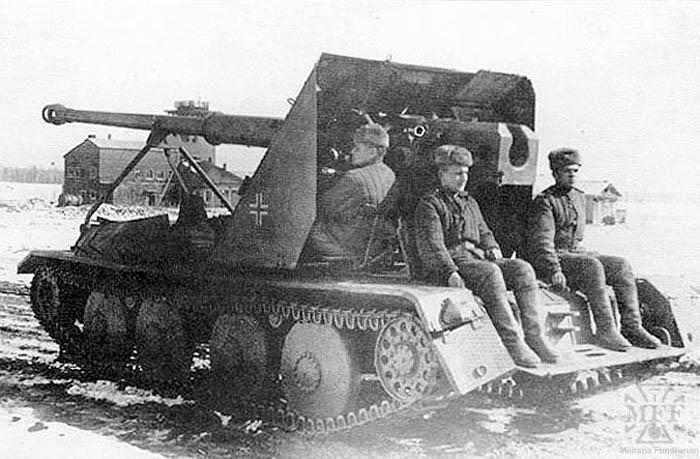 |
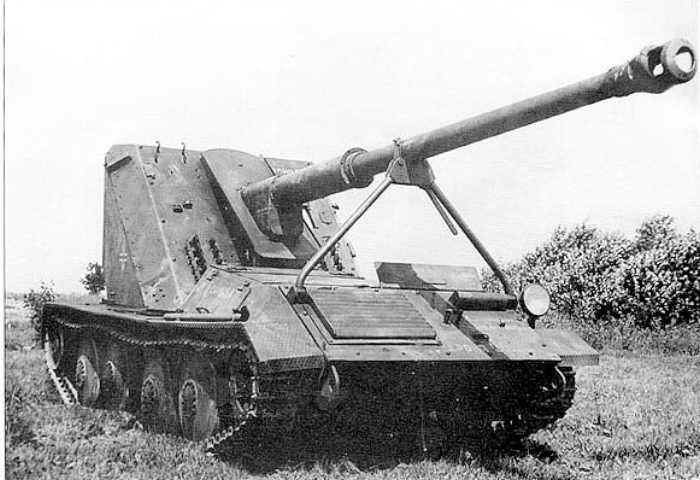 |
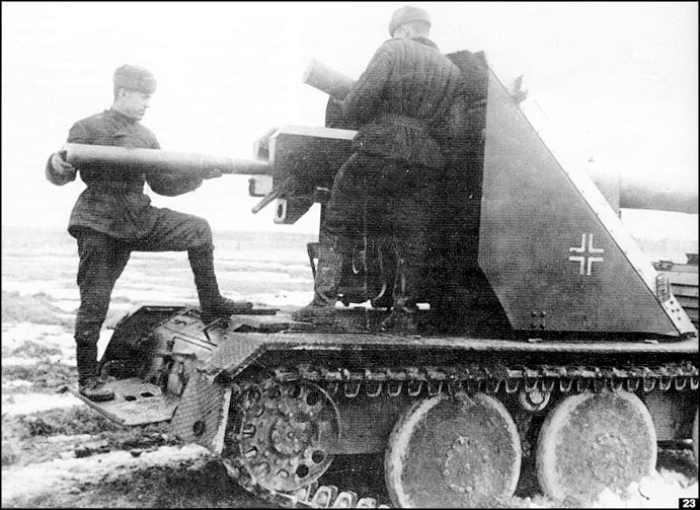 |
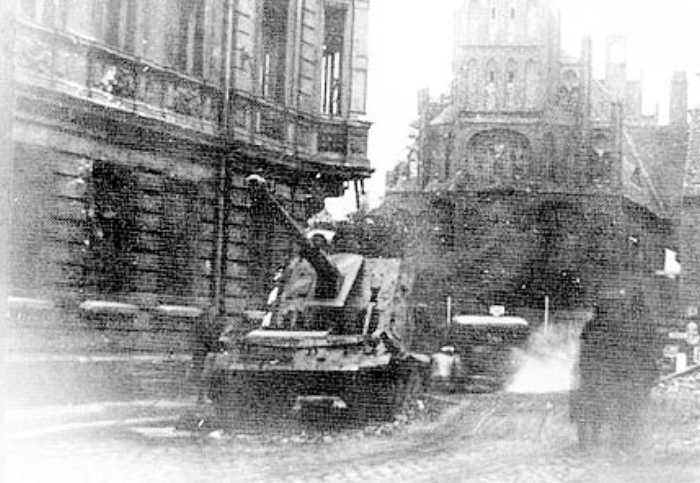 |
At least two vehicles were captured by the Red Army and one of them is conserved in Kubinka Museum.
Technical Data
Weight: 11200 kg
Crew 4
Length 7 .270 m /gun
Width 2.440
Heigth 2.4 m
Engine
Speed 36km/h
Range 150 kms
Armour 20 mm maxi
Weapon
8,8 cm Pak 43/3 L71 with 50 round + 20 in a towed trailer
Radio FuG 16